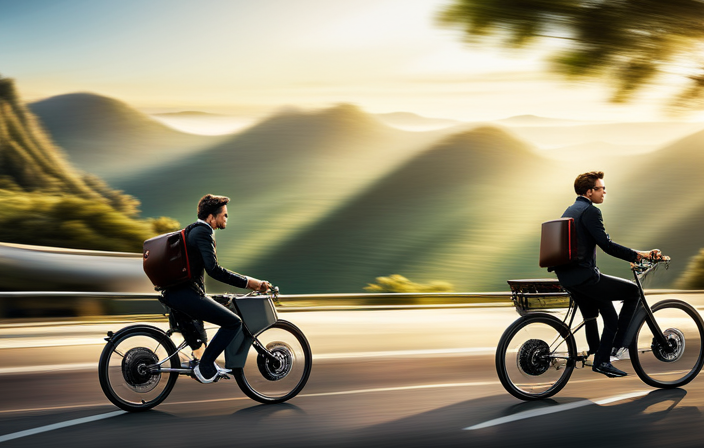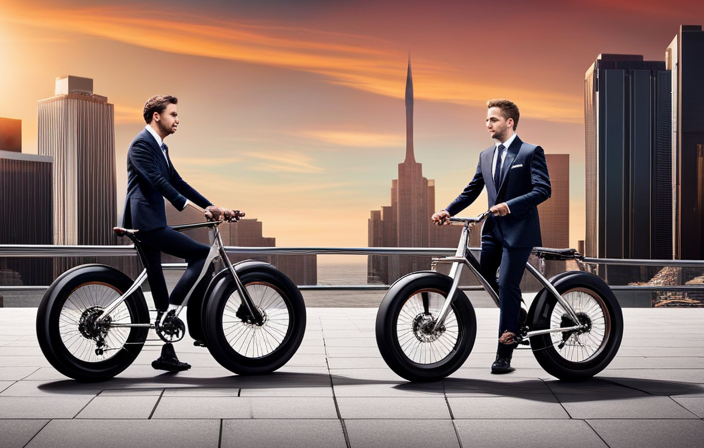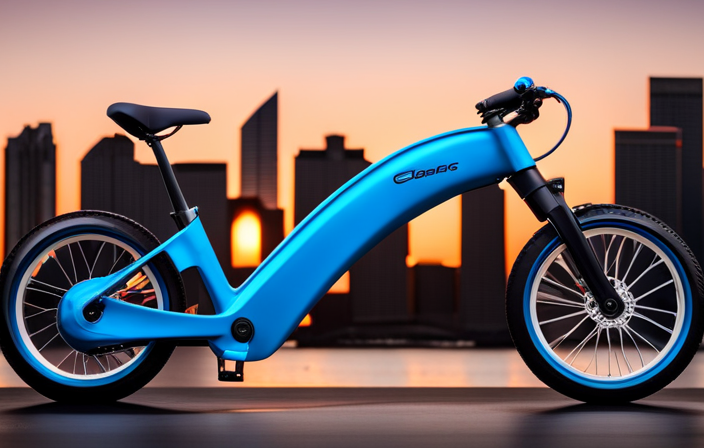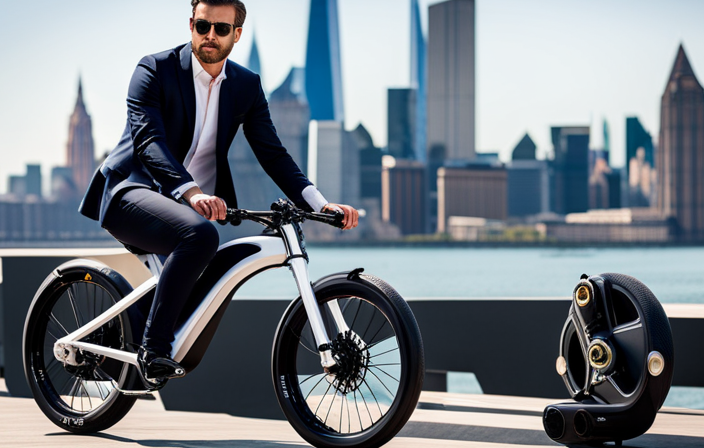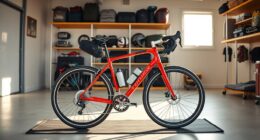Curious about the horsepower of an electric bike? Get ready to dive into the technical world of electric bike motors, voltage, amps, watts, and torque.
We’ll compare hub motors and mid-drive motors, explore the relationship between power and speed, and discuss how power accessories can enhance performance.
But before we go any further, it’s important to understand the legal limitations and choose the right electric bike for your power needs.
So, let’s explore the fascinating world of electric bike power together.
Key Takeaways
- Motor efficiency, controller quality, and programming optimization affect the horsepower output of an electric bike.
- Investing in a high-quality controller with better components can enable smoother power delivery, resulting in increased power output.
- Motor efficiency, which is the ratio of useful output power to input power, plays a crucial role in maximizing horsepower output.
- Understanding the difference between rated power and peak power helps evaluate the motor’s capabilities and performance.
Understanding Electric Bike Motors
The electric bike’s motor determines its horsepower. When it comes to motor types, there are two main options: hub motors and mid-drive motors.
Hub motors are located in the bike’s wheels and are known for their simplicity and quiet operation. On the other hand, mid-drive motors are positioned near the pedals and provide a more natural riding experience by leveraging the bike’s gears. Both motor types have their advantages and it ultimately depends on personal preference.
Another important factor to consider is battery technology. Lithium-ion batteries are the most common choice for electric bikes due to their high energy density and long lifespan. They provide the power needed to drive the motor and determine the bike’s overall performance.
Now, let’s delve into the role of voltage in determining power.
The Role of Voltage in determining Power
Start by understanding that voltage plays a crucial role in determining the power of an electric bike. The voltage level directly affects the power output of the motor. Here are four key points to consider:
-
Voltage and Power Efficiency: Higher voltage generally leads to higher power efficiency. This means that a higher voltage motor can convert more electrical energy into mechanical power, resulting in a more efficient electric bike.
-
Impact of Voltage on Speed: Increasing the voltage can also increase the top speed of the electric bike. This is because higher voltage allows the motor to rotate faster, generating more power and enabling the bike to reach higher speeds.
-
Current and Power Output: It’s important to note that while voltage impacts power, current also plays a significant role. Higher current levels can increase the power output of the motor, but it comes at the expense of reduced battery life.
-
Finding the Optimal Voltage: Finding the right voltage for your electric bike depends on various factors, such as the desired power output, battery capacity, and intended use. It’s crucial to strike a balance between power and battery life to optimize the overall performance of the bike.
Understanding the relationship between voltage and power is just the beginning. Now let’s explore amps and watts: exploring the electric bike equation.
Amps and Watts: Exploring the Electric Bike Equation
Let’s dive into the relationship between amps and watts in the electric bike equation.
When it comes to determining the power of an electric bike, both amps and watts play a crucial role. Amps, short for amperes, measure the electrical current flowing through the system. Watts, on the other hand, represent the power generated by the electric bike.
The formula for calculating power is simple: watts = volts x amps. In order to maximize the power output of an electric bike, it is important to consider both battery capacity and controller efficiency.
A higher battery capacity allows for a greater flow of amps, resulting in more power. Additionally, an efficient controller ensures that the electricity is properly regulated, optimizing the conversion of amps into watts.
Understanding the relationship between amps and watts is essential in comprehending the overall power of an electric bike.
Transitioning into the subsequent section about torque, it is important to note that torque is the force behind electric bike power.
Torque: The Force Behind Electric Bike Power
To fully understand the force behind the power of your electric bike, you need to grasp the concept of torque. Torque is the rotational force that allows your bike to accelerate and climb hills. Electric bike torque control plays a crucial role in determining how quickly your bike can reach its top speed and how efficiently it can tackle steep inclines.
Here are four key things to know about torque and its impact on your electric bike’s performance:
- Torque is directly related to acceleration. The higher the torque, the quicker your bike can accelerate.
- Electric bikes with higher torque can handle steeper inclines with ease.
- Torque control allows for more precise and efficient power delivery.
- Different electric bike models may have different torque ratings, so it’s important to consider your specific needs and riding preferences.
Understanding torque is essential when comparing hub motors vs. mid-drive motors, which we’ll delve into in the next section.
Comparing Hub Motors vs. Mid-Drive Motors
When comparing hub motors and mid-drive motors, you’ll find that they have distinct advantages and disadvantages. Hub motors are located in the center of the wheel and provide direct power to the wheel, eliminating the need for a chain drive system. This makes them simpler and easier to maintain, as there are fewer moving parts. On the other hand, mid-drive motors are positioned near the bottom bracket of the bike, which allows them to take advantage of the bike’s existing gears. This results in more efficient power transfer and better hill climbing ability.
To help you understand the differences between these two types of motors, here is a comparison table:
| Hub Motors | Mid-Drive Motors |
|---|---|
| Simple and easy to maintain | Utilizes existing gears for efficient power transfer |
| Direct power to the wheel | Better hill climbing ability |
| No need for a chain drive system | Can be more expensive |
As you can see, both hub motors and mid-drive motors have their own advantages. Now, let’s delve into the next section and explore the impact of battery capacity on power.
Battery Capacity and its Impact on Power
Now that you understand the differences between hub motors and mid-drive motors, let’s delve into the importance of battery capacity and its impact on power.
When it comes to electric bikes, the battery is the lifeblood of the machine, providing the necessary energy for the motor to propel you forward. The battery capacity directly affects the power output of the bike, as it determines how long the bike can sustain a certain level of performance.
Additionally, battery life and charging time are crucial factors to consider. A larger battery capacity will generally provide a longer range and allow for more frequent rides without the need for recharging. However, keep in mind that larger batteries may also require longer charging times.
Speaking of power and efficiency, the next section will discuss the crucial role played by the controller in optimizing performance.
Controller Efficiency and Performance
Get the most out of your ride by understanding how the controller improves efficiency and enhances performance.
The controller plays a crucial role in optimizing power for your electric bike. It regulates the flow of electricity from the battery to the motor, ensuring that power is delivered efficiently and effectively.
A high-quality controller can maximize the power output of your electric bike, allowing you to reach higher speeds and tackle steeper inclines. By efficiently managing the power flow, the controller minimizes energy waste and prolongs the battery life. It also allows for smoother acceleration and deceleration, enhancing your overall riding experience.
Factors such as the controller’s design, quality, and programming can significantly impact the bike’s power output. Understanding these factors will help you make informed decisions when choosing an electric bike.
Factors Affecting Electric Bike Power Output
Factors such as the controller’s design, quality, and programming can greatly impact how much power your electric bike is capable of producing. To optimize power output, consider the following:
-
Motor types: Different motor types, such as brushed or brushless, can affect power output. Brushless motors are generally more efficient and provide higher power.
-
Controller design: The controller acts as the brain of the electric bike, controlling the power flow. A well-designed controller can ensure efficient power delivery and maximize power output.
-
Controller quality: High-quality controllers are built with better components, allowing for smoother power delivery and increased power output.
-
Controller programming: Optimizing the controller’s programming can enhance power output by fine-tuning factors such as acceleration, torque, and top speed.
Considering these factors when selecting or upgrading your electric bike’s controller can significantly impact its power output.
Next, we will explore how motor efficiency influences horsepower.
How Motor Efficiency Influences Horsepower
To optimize the horsepower of your electric bike, consider how motor efficiency plays a role. Motor power is the amount of work the motor can do in a given time, and efficiency is the ratio of useful output power to input power. In the case of electric bikes, motor efficiency analysis is crucial in determining the overall horsepower output. A more efficient motor will convert a higher percentage of electrical power into mechanical power, resulting in greater horsepower.
To visualize this, consider the following table:
| Motor Efficiency (%) | Horsepower Output |
|---|---|
| 80 | 5 |
| 85 | 5.5 |
| 90 | 6 |
| 95 | 6.5 |
As the motor efficiency increases, the horsepower output also increases. Therefore, selecting a motor with high efficiency is essential for maximizing the power output of your electric bike.
This analysis leads us to the subsequent section, where we will discuss the difference between rated and peak power.
The Difference Between Rated and Peak Power
The distinction between rated and peak power is important to understand when considering the performance of an electric bike.
Rated power refers to the maximum power output that the motor can sustain continuously without overheating or damaging the components. It is the power level that the motor is designed to operate at for extended periods of time.
On the other hand, peak power refers to the maximum power output that the motor can achieve for short bursts of time, typically during acceleration or when climbing steep hills. This is the power level that the motor can reach momentarily before it starts to overheat.
Understanding the difference between rated and peak power allows riders to have a better understanding of the motor’s capabilities and its performance under different conditions.
Now, let’s explore the options of power modes and how they can enhance your riding experience.
Power Modes: Exploring the Options
Exploring the options of power modes can greatly enhance your riding experience. Power management plays a crucial role in optimizing battery life for electric bikes. Here are three power modes that you can choose from:
-
Eco Mode: This mode prioritizes energy efficiency over speed, perfect for conserving battery life on longer rides or when you need to travel longer distances.
-
Sport Mode: In this mode, you can enjoy a balance between power and battery consumption. It offers a good combination of speed and range, making it suitable for everyday commuting.
-
Turbo Mode: If you crave maximum power and speed, this mode is for you. It provides the highest level of assistance, allowing you to reach higher speeds quickly, but it may drain your battery faster.
By understanding and utilizing these power modes, you can effectively manage your electric bike’s power output while optimizing battery life.
Transitioning to the subsequent section about the relationship between power and speed, you’ll learn how your chosen power mode affects the overall performance of your electric bike.
The Relationship between Power and Speed
Understanding how power and speed are related can greatly enhance your riding experience on an electric bike.
When it comes to power and acceleration, it’s important to note that the higher the power output of your electric bike, the faster it can go. More power means quicker acceleration, allowing you to reach higher speeds in less time.
However, it’s essential to consider the impact of power on battery life. Higher power output requires more energy, which can drain the battery faster. Therefore, finding the right balance between power and battery life is crucial.
By understanding this relationship, you can optimize your riding experience by adjusting the power settings accordingly. This knowledge will help you make informed decisions about enhancing your electric bike’s performance with power accessories that can further improve your riding experience.
Enhancing Electric Bike Performance with Power Accessories
Enhancing your electric bike’s performance can be accomplished by adding power accessories. By carefully selecting the right power accessories, you can significantly enhance your electric bike’s performance and overall riding experience. Here are four power accessories that can take your electric bike to the next level:
-
High-capacity battery: Upgrade to a high-capacity battery to increase your bike’s range and minimize the need for frequent recharging.
-
Performance motor: Replace your stock motor with a high-performance one to boost your bike’s acceleration and top speed.
-
Regenerative braking system: Install a regenerative braking system to convert the kinetic energy from braking into electrical energy, which can be stored and utilized later.
-
Performance tires: Opt for performance tires that offer better traction, grip, and stability, allowing you to ride with confidence even on challenging terrains.
By utilizing these power accessories selection and performance enhancement techniques, you can transform your electric bike into a high-performing machine.
Now, let’s delve into the legal limitations of electric bike power.
The Legal Limitations of Electric Bike Power
To fully comply with regulations, you need to be aware of the legal limitations on the power of your electric bike. The power limitations for electric bikes vary depending on the country and region you are in. In most cases, the maximum power allowed for an electric bike is 750 watts (1 horsepower). Exceeding this limit may result in your electric bike being classified as a motorcycle, which may require a license, registration, and insurance. It is important to check the specific legal requirements in your area to ensure that your electric bike falls within the permissible power range. Failure to comply with these regulations can lead to penalties and legal issues. Understanding the power limitations will help you choose the right electric bike for your power needs, ensuring that you stay within the legal boundaries.
Now let’s explore the next section about choosing the right electric bike for your power needs.
Choosing the Right Electric Bike for Your Power Needs
When choosing the right electric bike for your power needs, you should consider factors such as your desired speed and distance. To determine the power requirements of your electric bike, you need to evaluate your intended usage.
If you plan on using your electric bike for short commutes or leisurely rides, a lower power motor may be sufficient. However, if you have longer distances to cover or need to tackle steep inclines, a higher power motor would be more suitable. Motor selection is crucial in meeting your power requirements.
Different electric bikes come with various motor options, such as hub motors or mid-drive motors. Hub motors are generally easier to maintain and provide a more straightforward riding experience, while mid-drive motors offer better balance and hill-climbing capabilities.
Evaluating your power needs and considering the motor selection will help you choose the right electric bike for your specific requirements.
Frequently Asked Questions
Can I increase the horsepower of my electric bike by upgrading the battery capacity?
Yes, upgrading the battery capacity of your electric bike can indeed increase its horsepower. By upgrading the battery, you can provide more power to the motor, which in turn can result in a higher horsepower output.
Additionally, increasing the battery capacity can also help increase the speed of your electric bike. So, if you are looking for more horsepower and increased speed, upgrading the battery capacity is a great option to consider.
What are the legal limitations on the power output of an electric bike?
The legal limitations on the power output of an electric bike are determined by various regulations. These regulations typically restrict the maximum power output of electric bikes to a certain level, often measured in watts.
The specific limitations can vary depending on the country or region. It is important to ensure that your electric bike complies with these power output limitations to avoid any legal issues or penalties.
How do power accessories enhance the performance of an electric bike?
To enhance the performance of an electric bike, power accessories play a crucial role. These accessories, such as high-capacity batteries and advanced motor controllers, significantly boost the bike’s power output.
For instance, a study found that equipping an electric bike with a high-capacity battery increased its top speed by 20% and extended its range by 30%. Additionally, advanced motor controllers ensure efficient power delivery, resulting in improved acceleration and overall performance.
These power accessories revolutionize the riding experience, making electric bikes more powerful and versatile.
What factors should I consider when choosing an electric bike for my power needs?
When choosing an electric bike for your power needs, there are several factors to consider.
First, look at the electric bike power range, which indicates how far the bike can travel on a single charge. The battery capacity and type, motor power, and weight of the bike all affect its power.
Other factors include the terrain you will be riding on, your weight, and desired speed. Considering these factors will help you find an electric bike that meets your power requirements.
Can you explain the difference between rated power and peak power in electric bike motors?
The difference between rated power and peak power in electric bike motors is crucial to understand.
Rated power refers to the continuous power output that a motor can sustain over a long period.
On the other hand, peak power represents the maximum power output that the motor can deliver for short bursts.
It is important to note that torque and power are not the same.
Torque is the rotational force produced by the motor, while power is the rate at which work is done.
Additionally, motor efficiency plays a significant role in determining the overall performance and energy consumption of an electric bike.
Conclusion
In conclusion, when it comes to electric bikes, understanding the power is crucial. The combination of voltage, amps, and watts determines the overall horsepower of the bike.
Additionally, torque plays a significant role in the force behind the bike’s power. Whether you choose a hub motor or a mid-drive motor, each has its own advantages.
Remember that power directly affects speed, and for enhanced performance, power accessories can make a difference. However, it’s important to be aware of the legal limitations surrounding electric bike power.
So, choose wisely and ride with power!
